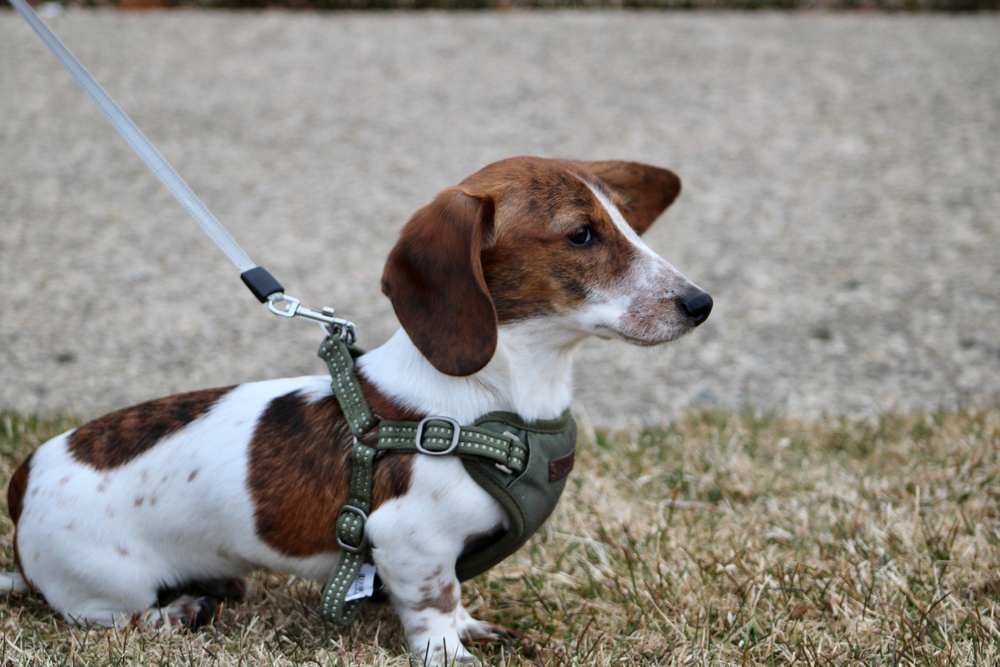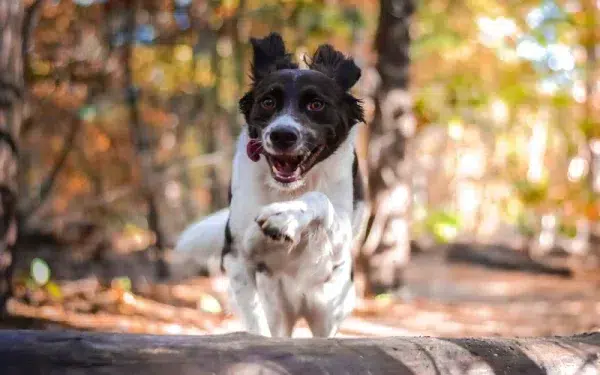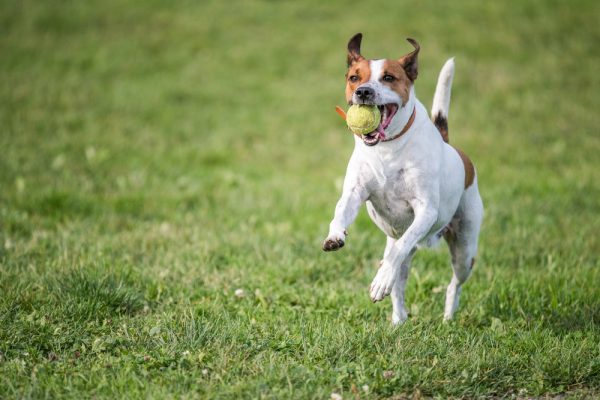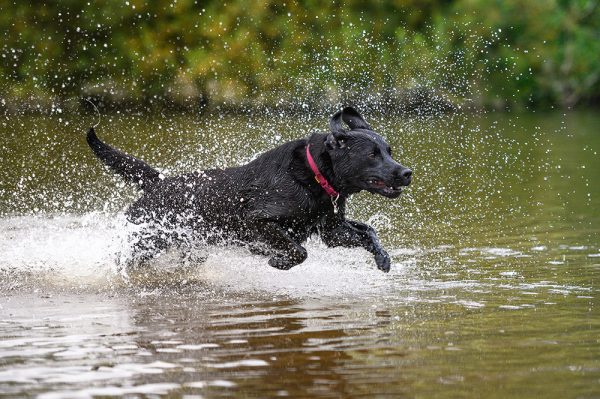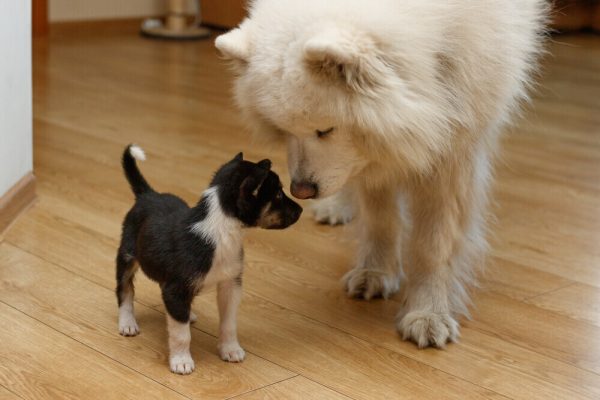Dachshunds are small and adorable with the attitude of a large breed. They may seem playful and friendly at first glance, but as you begin to know them, you will find that they can be quite challenging to train due to their stubborn and independent nature. So, if you’re planning to adopt a Dachshund, be ready to invest a lot of time and effort in their training.
Don’t be afraid, though! Dachshund Training won’t be too difficult if you know how to do it correctly. The key is patience. Since these dogs are quite willful, you need to be gentle and find their motivations for training.
If you’re new to dog parenting, this guide will discuss some helpful tips to help you easily train your little Doxie. So, let’s dive in!

How to Train a Dachshund Puppy
Before you start your Dachschund’s training, break it down into smaller sessions to gradually make your pup accustomed to this new thing. This method will ensure your puppy enjoys their training without getting too tired.
Here are some tips for training your young pup.
1. Allow the Puppy to Get Familiar With Your Home
Before you bring your new dog home, make sure to puppy-proof your entire house beforehand. This includes decluttering the rooms, removing small items your pup may swallow, hiding kids’ toys and electrical cords, etc. Simply eliminate anything that could risk your pup’s safety. At first, you must confine the dog in a small room and then introduce them to other parts of the home. This way, they won’t be overwhelmed.
Remember, you can’t train a dog that isn’t comfortable in their environment. If you force your pup for training right after bringing them home, they may feel threatened and show destructive behavior.
Dogs need time to build habits in their new surroundings, especially a puppy, as they are going through a huge change in their daily life without their mother and siblings. So, you should be patient and gradually let them discover their new home and understand they’re completely safe here.
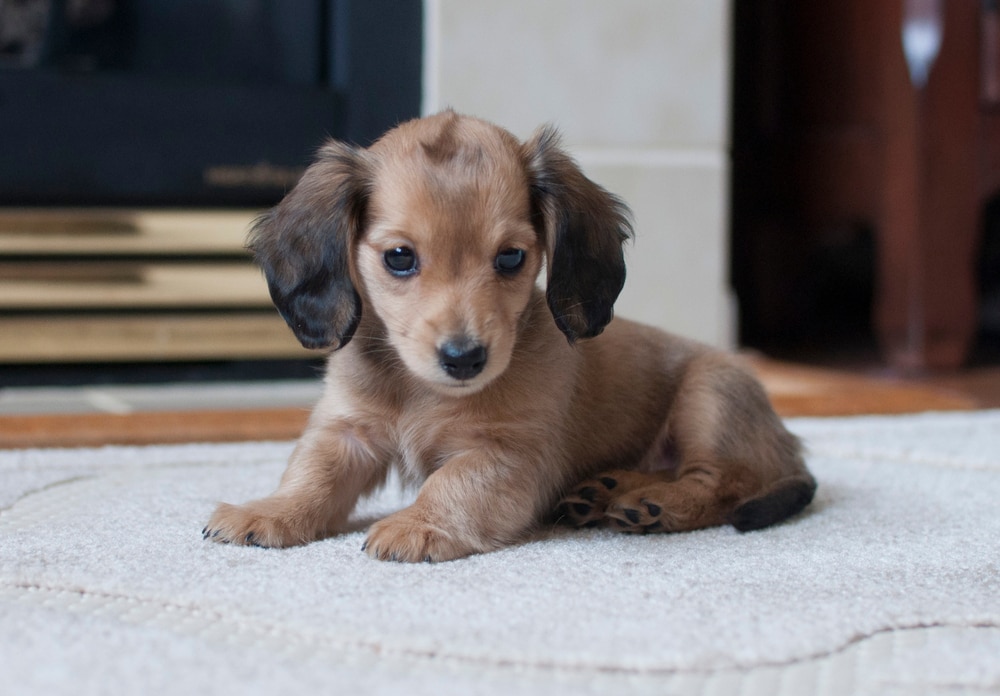
2. Train Your Pup Early
Once your puppy is familiarized with their new home, you should begin their training as soon as possible. The ideal age to train a Dachshund puppy is 8 to 12 weeks. That’s when the pup has been weaned from their mother and is ready to enter the real world.
An 8-week-old puppy is also curious enough to experience new things, making them receptive to training. Potty training, crate training, name recognition, learning “come” and “sit,” and socialization should be the first goals on your Dachshund’s training schedule.
3. Discourage Chewing
Teething puppies chew anything they get their paws on. The same is true with Dachshunds, as these dogs love to chew household items like shoes, books, and furniture. This destructive behavior is instilled in them naturally, so don’t discourage them harshly.
Instead, be gentle, firmly tell them ” No, ” and take the item from them. Make sure to do so when they’re chewing. If you do it once they are done, they won’t understand what you are correcting them for.
Provide your pup with chewing toys to help them satisfy their urge. Praise them when they chew on the toys, so they know that they are doing the right thing.
Scolding your dog physically or verbally will make them scared of you, which may make your Dachshund training sessions a headache.

4. Make Them Sociable Through Puppy Kindergarten
Learning socialization is important for Dachshunds, especially in their puppyhood. You can enroll your Doxie in a puppy kindergarten 1 week after they have had their first set of vaccines and deworming. These classes can help them learn how to coexist with other dogs and people. Puppies should be kept up to date with the rest of their vaccination schedule throughout the classes.
These classes will also teach basic obedience skills to your pup in an enjoyable manner. They will learn how to respond when someone commands them to “stand” or “stay.” To get maximum results, you must choose the best trainer for your puppy.
Once your Doxie knows how to get along with other dogs and a week has passed after the entire puppy vaccination schedule is completed, you can take them to your nearby dog-friendly park to help them socialize. This will help them become comfortable with this new life experience.

How to Train a Dachshund to Use a Crate
Crate training is essential for Dachshund puppies, as they can spend time in their designated space. This way, they won’t chew household items and can relax in their crate when the outside environment becomes too much for them.
1. Select the Right Crate
To make your dog comfortable, you must get a crate according to their size. It must have enough space for the Doxie to move around easily, but it shouldn’t be too big to give them room to poop or pee inside.
You will find many crate options in the market for your Dachshund, making it hard to choose one. If your dog is curious, you should get a wire crate, as it will enable them to see what’s happening in their surroundings.
The ideal crate for a Doxie puppy is expandable and can be adjusted as they grow. For an adult Mini Dachshund, a 24″ x 18″ x 21″ crate usually works well, and for a Standard, you will probably need a 31″ x 21″ x 24″ crate.
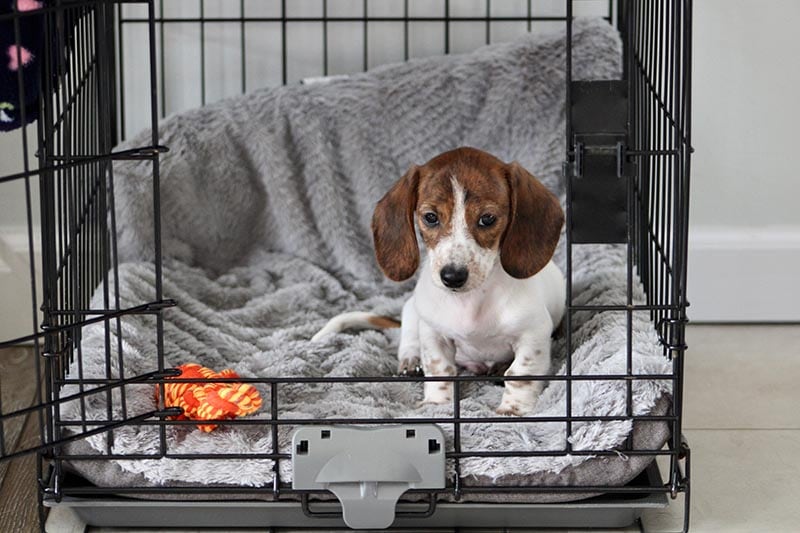
2. Put the Crate in an Activity Room
Dachshunds like to be around humans, particularly their owners. Crate training can make them lonely, encouraging them to resist living in their new home.
To prevent this, you must place their crate in a room with plenty of human activity. It could be the living or family room. Doing so will help your Doxie keep an eye on the activities of other members without feeling like a stranger in the home.
3. Make Your Dachshund Comfortable
Your dog’s crate must provide comfort to them, or it won’t be useful. Place a soft bed or blanket inside the crate to make them feel at home. They will also need access to a water bowl to stay hydrated.
You can put safe toys in their crate that they can play with. Since dogs love to chew, you should also include chew toys to satisfy their urge.
Remember, your Doxie needs to feel safe and comfortable inside their crate, not perceive it as punishment. The crate is just a training tool, so your pup shouldn’t be left inside for extended periods. Dogs are social creatures that do best when in the company of their human pack members.
4. Train Your Dog to Live in the Crate
Your Doxie will need your help to stay in the crate for extended periods. At first, they may show resistance to entering their new home. So, begin with short periods and then extend the duration gradually.
The best way to tell your dog to go inside the crate is through a one-word command. For instance, you can say “crate.” You can also entice your pup through their favorite treats so they can establish a positive association with their new home.
When you leave them alone, your Doxie may whine or cry in the beginning. Don’t pick them up for consolation. Instead, act like you didn’t hear them, and let them understand that crying won’t help them in this case.
Once your dog seems comfortable, you can give them a treat in the crate before allowing them out. Ensure to take them out often enough to empty their bladder.
If you are worried about your dogs behavior, we suggest speaking with a vet
If you need to speak with a vet but can't get to one, head over to PangoVet. It's our online service where you can talk to a vet online and get the advice you need for your pet — all at an affordable price!


How to Potty Train a Dachshund
House or potty training teaches a Dachshund how and when to use the bathroom. It becomes easier if you have already crate-trained your puppy. Generally, dogs take several weeks to complete their house training, so be patient.
1. Establish Your Dog’s Feeding and Bathroom Routine
Whether you have an adult or a puppy, you can potty train your Dachshund at any age. That said, it is easier to do in their puppyhood. Start by setting their feeding and bathroom schedule.
If your dog eats three times a day, you should take them outside to go potty about 15 minutes after they are done eating. This way, they will learn to eliminate outside the house and not inside. Your pup will also need to go to the toilet first thing in the morning, before bedtime, and after they have spent a long time in the crate.
Remember, puppies younger than 4 months can hold their bladder for only an hour every month of their age. For example, a 3-month-old Doxie may need to pee after every 3 hours. However, that’s just an estimate, and your pup may require peeing sooner or later than that.
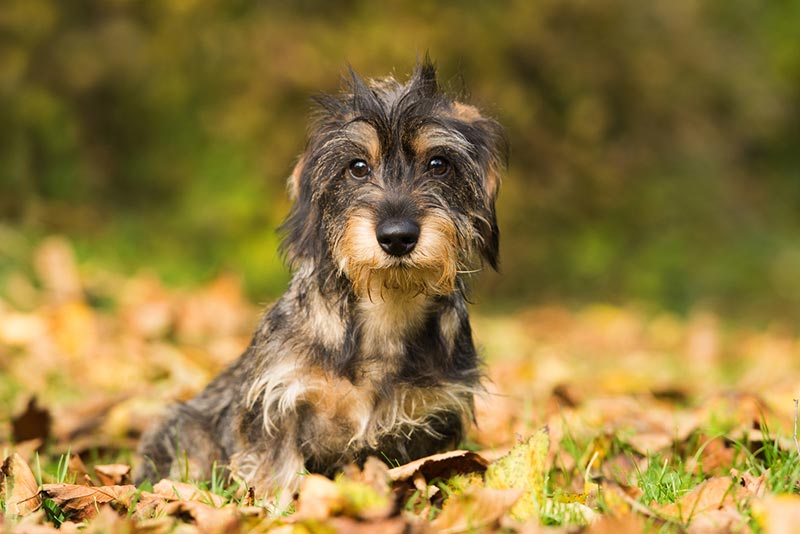
2. Give Your Dachshund Treats When They Pee Outside
Positive reinforcement goes a long way in training a Dachshund. The best way to make your adorable pup accustomed to outside peeing is by asking them to choose their elimination spot. Once they’re done, reward them with a treat and lots of praise.
Reward your pet whenever they go to the bathroom outside to let them understand that it’s a good thing.
Never rush your Doxie to eliminate outside, as it will make them anxious. They may start to avoid peeing outside by holding their bladder for extended periods. That’s quite unhealthy for the dog and can lead to a mess inside the home.
3. Don’t Scold Your Pet for Accidental Messes
Your Dachshund will take time to learn to eliminate outside, so don’t expect them to be pro in a few days. They may urinate or defecate inside the home in the beginning. Instead of punishing or scolding them out of frustration, be patient and clean up after them without making a fuss.
Use a strong pet urine cleaner to clean the soiled area. If it keeps smelling like urine, your dog may urinate there again.
To discourage this behavior, tell your pup a firm “no” when they are urinating or defecating inside the home. Then, pick them up and take them outside. Scolding your dog for such innocent accidents will only make them fearful of you.
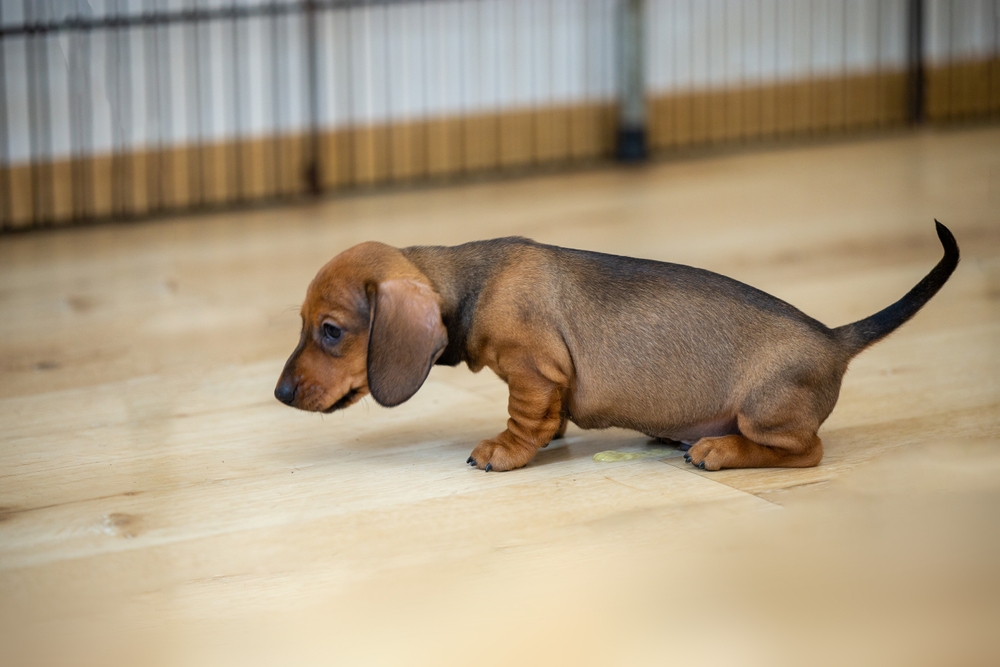

How to Train a Dachshund for On-Leash Walks
Last but not least, your Dachshund must learn how to walk on a leash, since these dogs have a strong prey drive. This instinct becomes even more active when they grow older. Leash training will also enable you to manage your dog in public places.
Here are some tips to help you train your Dachshund for on-leash walks.
1. Get the Right Harness and Leash
With so many harness and leash options on the market, it can be hard to buy a suitable one for your dog’s size. Simply measure your pup first to ensure that you find a well-fitting harness and leash for your Doxie.
2. Allow Your Dog to Get Calm Before Going Out
Before putting the harness and the leash around your puppy’s neck, allow them to sniff the tools to know they aren’t in danger. You must also ensure that the leash and the harness are not too tight around your pup’s neck and that these fit them comfortably.
However, there is another thing to consider before going out for an on-leash walk. Never put the harness on your dog when they are too excited for the walk. This can teach them they can do this anytime they want your attention.
So, whenever you see your pup getting too overwhelmed, drop the leash and the harness, and leave. Only return when the dog seems calm, and then you can put on the tools.
It’s recommended to anchor the leash in your left hand and hold the excess in your right one.
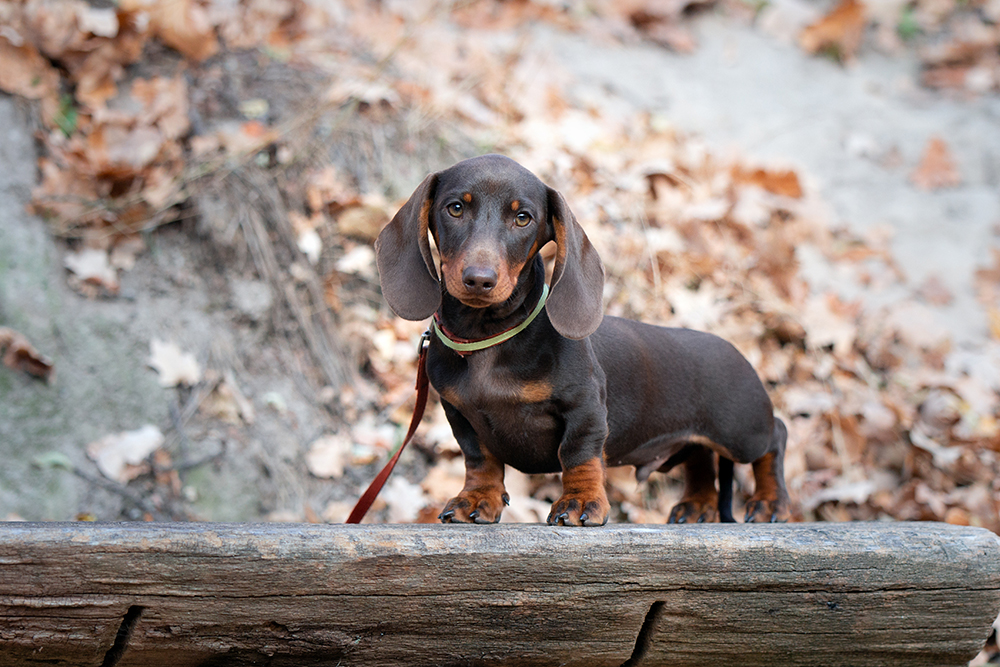
3. Discourage Leash Pulling
Sometimes, Dachshunds get so excited for outside walks that they start pulling on the leash. You should discourage this behavior, as it will only worsen. To cope with this, you must stand still.
Once your Doxie is calm and stops pulling, you can relax the leash and continue walking. They will soon learn that pulling gets them nowhere.
As your Doxie learns good leash etiquette, you should give them their favorite treats during the walk to encourage good behavior.
4. Teach Heeling to Your Dachshund
Heeling is when your dog walks beside you without pulling the leash. To help your Doxie learn it, you must make them walk on your left side while on the leash and harness. Keep the leash in your left hand and your pet’s favorite toy in the other hand.
Now, cross your right hand around your body so the dog can see the toy. Immediately say “heel” and walk forward while positioning the toy before the Doxie.
You can also use your pet’s favorite treat instead of the toy. As your dog learns how to heel, reward them with kibbles and verbal appreciation to encourage this behavior.

Conclusion
Training a Dachshund puppy helps the dog become a well-behaved adult. You can train your Doxie at any point in their life, but the best time is when they are in puppyhood. At this time, they are quite energetic and open to new challenges. Puppies are also easier to manage than adult dogs.
You should practice potty and crate training with your Dachshund puppy to help them adjust to living in a home. They must also learn how to listen to your commands and walk on a leash.
Just be patient with your pup and take time for their daily training. Your intelligent Dachshund will likely learn everything in only a few weeks!
See also:
Featured Image Credit: Jaclyn Vernace, Shutterstock

